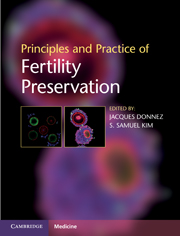Book contents
- Principles and Practice of Fertility Preservation
- Principles and Practice of Fertility Preservation
- Copyright page
- Dedication
- Contents
- Contributors
- Foreword
- Foreword
- Preface
- Acknowledgements
- Section 1 Introduction
- Section 2 Cancer biology, epidemiology and treatment
- Section 3 Reproductive biology and cryobiology
- Chapter 9 Life and death in the germ line
- Chapter 10 Molecular aspects of follicular development
- Chapter 11 Fundamental cryobiology of reproductive cells and tissues
- Chapter 12 Fundamental aspects of vitrification as a method of reproductive cell, tissue and organ cryopreservation
- Section 4 Fertility preservation strategies in the male
- Section 5 Fertility preservation strategies in the female: medical/surgical
- Section 6 Fertility preservation strategies in the female: ART
- Section 7 Ovarian cryopreservation and transplantation
- Section 8 In vitro follicle growth and maturation
- Section 9 Future technologies
- Section 10 Ethical, legal and religious issues with fertility preservation
- Index
Chapter 11 - Fundamental cryobiology of reproductive cells and tissues
Concepts and misconceptions
from Section 3 - Reproductive biology and cryobiology
Published online by Cambridge University Press: 04 February 2011
- Principles and Practice of Fertility Preservation
- Principles and Practice of Fertility Preservation
- Copyright page
- Dedication
- Contents
- Contributors
- Foreword
- Foreword
- Preface
- Acknowledgements
- Section 1 Introduction
- Section 2 Cancer biology, epidemiology and treatment
- Section 3 Reproductive biology and cryobiology
- Chapter 9 Life and death in the germ line
- Chapter 10 Molecular aspects of follicular development
- Chapter 11 Fundamental cryobiology of reproductive cells and tissues
- Chapter 12 Fundamental aspects of vitrification as a method of reproductive cell, tissue and organ cryopreservation
- Section 4 Fertility preservation strategies in the male
- Section 5 Fertility preservation strategies in the female: medical/surgical
- Section 6 Fertility preservation strategies in the female: ART
- Section 7 Ovarian cryopreservation and transplantation
- Section 8 In vitro follicle growth and maturation
- Section 9 Future technologies
- Section 10 Ethical, legal and religious issues with fertility preservation
- Index
Summary
Keywords
- Type
- Chapter
- Information
- Principles and Practice of Fertility Preservation , pp. 129 - 144Publisher: Cambridge University PressPrint publication year: 2011
- 1
- Cited by



